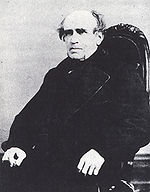James Ferguson (American astronomer)
James Ferguson | |
|---|---|
 James Ferguson | |
| Born | August 31, 1797 |
| Died | September 26, 1867 (aged 70) |
| Nationality | United States |
| Awards | Lalande Prize (1854) |
| Scientific career | |
| Fields | astronomy |
James Ferguson (August 31, 1797 – September 26, 1867) was an American astronomer and engineer (he helped build the Erie canal) born in Scotland who made the first discovery of an asteroid from North America (31 Euphrosyne). Starting in 1847, he worked at the U.S. Naval Observatory in Washington, DC.[1]
The asteroid 1745 Ferguson, discovered from the same observatory, was later named in his honour.
In 1850, he "lost" a star that he had been observing, which Lt. Matthew Maury, the superintended of the Observatory, claimed was evidence for a 9th planet (Pluto had not yet been discovered). In 1878, however, CHF Peters, director of the Hamilton College Observatory in New York, showed that the star had not in fact vanished, and that the previous results had been due to human error.[2]
| 31 Euphrosyne | September 1, 1854 |
| 50 Virginia | October 4, 1857 |
| 60 Echo | September 14, 1860 |
References
- ^ "The Observatory, Vol. 30". 1907. pp. 352–353. Retrieved 23 April 2014.
- ^ Morton Grosser (1964). "The Search For A Planet Beyond Neptune". Isis. 55 (2): 163–183. doi:10.1086/349825. JSTOR 228182.
